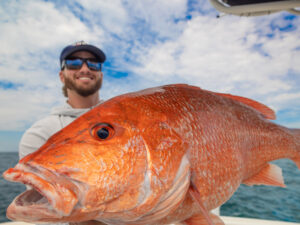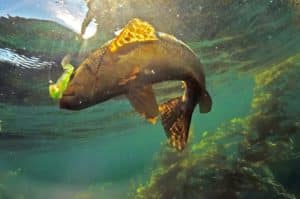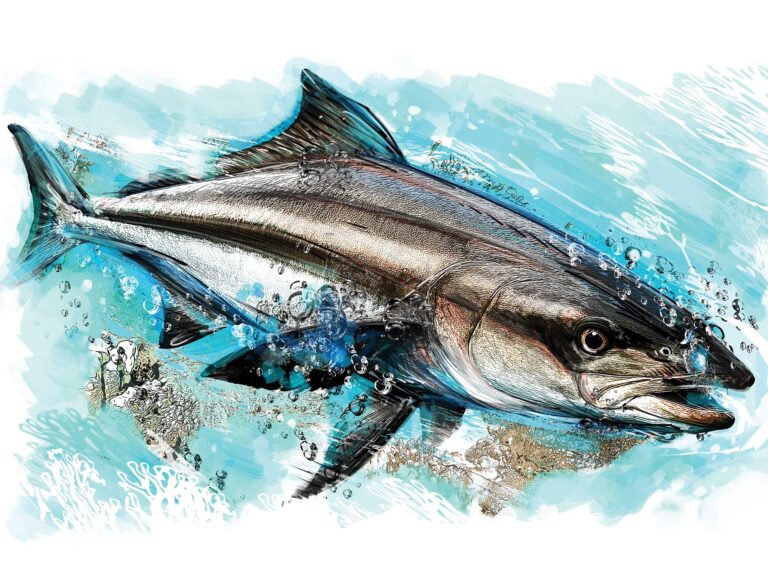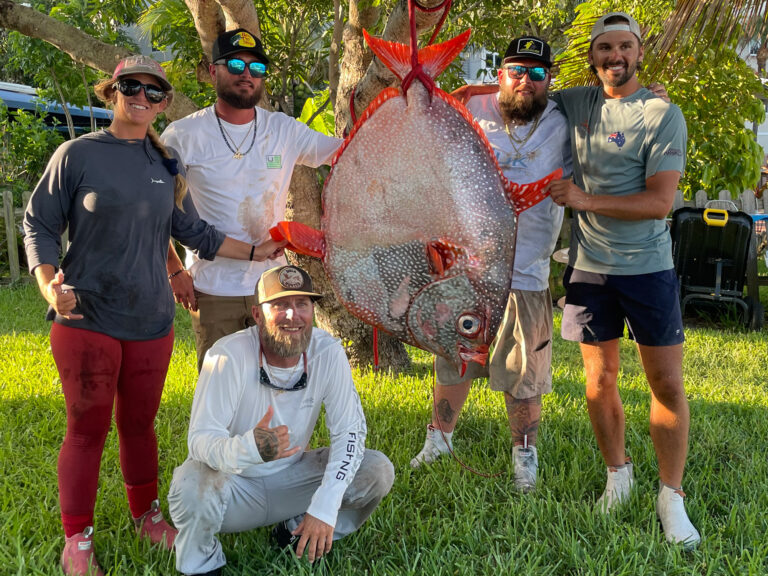In each issue of Sport Fishing magazine, a panel of five international expert ichthyologists identifies unusual and often amazing fishes in photos submitted by readers. Find out what they are and learn fascinating facts about them.
Jelly Gourmet
QUESTION:
I caught this fish near Sitka, Alaska, in about 270 feet of water while bottomfishing for halibut. I’ve identified it as a prowfish and have submitted it to the IGFA to be the first all-tackle record for the species. This one weighed 17.85 pounds and measured 36 inches; I’m wondering how much larger they’re known to get. From my research, it seems they eat mostly jellyfish, though this one struck a combination of herring and squid. But I couldn’t determine anything about prowfish edibility. What can you tell me about that and their maximum size?
Steve Ramp
Sitka, Alaska

ANSWER:
Good call, Steve. That is indeed a prowfish, Zaprora silenus. Prowfish range from Japan to the Arctic (in the Chukchi Sea) and down to southern California, so you were fishing in the heart of their territory. They grow to about 40 inches long (yours is almost maximum size), and the adults live near the bottom in depths ranging from 33 to at least 2,600 feet. Juvenile prowfish always seem to hang around jellyfishes; when frightened, they swim right up inside the bell or shelter near the tentacles. Adults live on reefs, usually in caves, so it sounds like you drifted off the sand and over some rocks. As you note, jellyfishes are a major part of their diet, as are krill, fish larvae, and other small planktonic creatures. Why a big glob of herring and squid attracted one of these fish is a mystery, but maybe it’s like me and rhubarb — I know I hate it, but every once in a while, I think, Oh, what the hell? and try some. Lastly, are they good to eat? I can’t find anyone who actually has tried one. However, my associate Alexei Orlov informs me that prowfish are occasionally used in surimi by Japanese fishermen who catch them by accident but says there is no market for them in Japan.
—Milton Love
Gold in Them Thar Depths
QUESTION:
While fishing a metal jig about 450 feet down off Mitsio Island near Nosy Be, Madagascar, my good friend Philippe Pletincx caught this and another like it. What can you tell us about these fish?
Jean Francois Helias
anglingthailand.com
Bangkok, Thailand
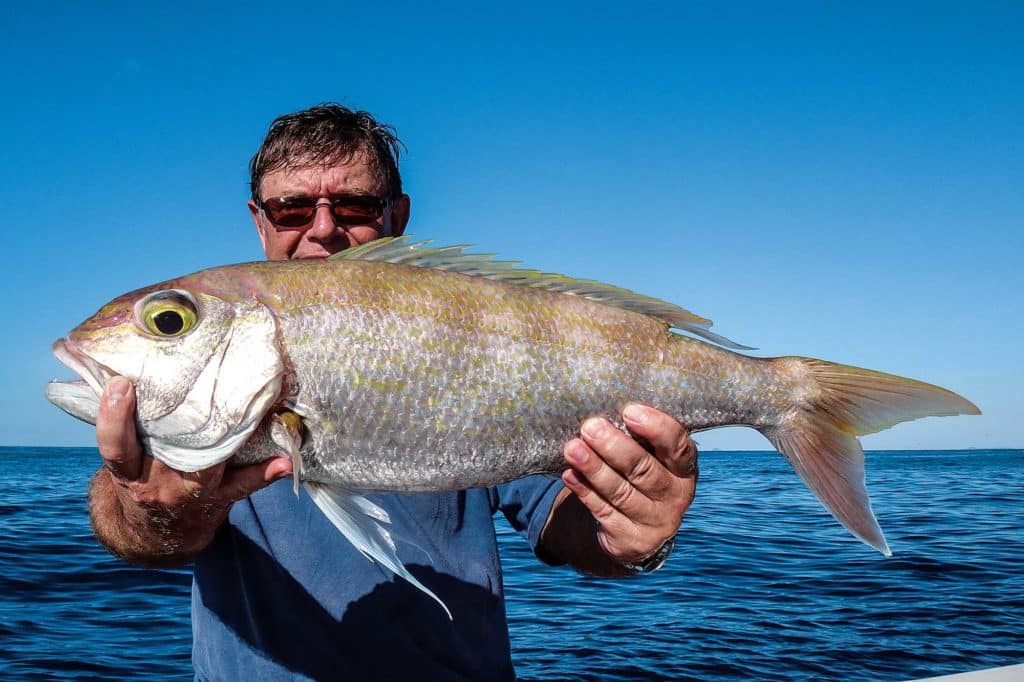
ANSWER:
That is a very nice specimen of a goldbanded jobfish (Pristipomoides multidens). These fish, also known as goldbanded snapper, are deepwater snappers (family Lutjanidae) that occur widely throughout the tropical Indo-Pacific region from Samoa in the Central Pacific west to the Red Sea in the western Indian Ocean. They appear very similar to several other closely related deepwater jobfishes but are differentiated by the broken yellowish-golden stripes on the flanks and two or three golden bands bordered with faint blue over the top of the head. This species matures at around 15 to 20 inches, and grows to around 36 inches and 20 or more pounds. Goldbanded snapper are a relatively slow-growing species with a maximum age around 30 years. They spend most of their lives near the seafloor in schools over areas of rocky reef or drop-offs near offshore islands to depths of over 600 feet, though most commonly in the 200- to 500-foot range. They feed mainly on other fishes but also crustaceans and squids, and are excellent eating.
—Ben Diggles
Permit Pretender
QUESTION:
A friend of mine caught this fish a few days ago, and it has generated a debate among Facebook anglers as to its identity as a permit or a palometa (Trachinotus goodei) or some other species. To me it looks like a palometa, but I’m not sure. Can your Fish Facts expert give us the answer?
Israel Umpierre
San Juan, Puerto Rico
ANSWER:
While it’s a difficult call, I believe this fish is a juvenile palometa (aka great pompano), Trachinotus goodei, rather than a juvenile permit, T. falcatus. I’m basing this identification mainly on the fish’s eye length relative to its head and fork length. Based on measurements I took from the photograph, the relative eye length of this fish is smaller than would be expected for permit of this size. It also appears that dark, narrow bands characteristic of adult palometa might be forming above this fish’s lateral line. The black, leading edges on the upper and lower lobes of the caudal fin, also characteristic of palometa, are apparent at this stage in development. Adult palometa and, to a lesser degree, permit have elongated rays on their dorsal and anal fins, but these have yet to form on this fish. Palometa frequent the surf zone along sandy beaches but can be found at depths to 40 feet around reefs. They range from Massachusetts to Argentina, including the Gulf of Mexico, Bermuda, the Bahamas and islands in the Caribbean Sea. Palometa are reported to be excellent table fare but have been known to cause ciguatera poisoning. They fight hard for their size but reach a maximum length of only around 20 inches.
—Ray Waldner
Rare Catch from Costa Rica
QUESTION:
I’ve caught more species of fish on a simple sabiki with bare gold hooks than using anything else. We caught this little guy while baitfishing near Puerto Jimenez, Costa Rica, in 80 feet of water. What is it?
Cory Craig
Tropic Fins Adventures
Puerto Jimenez, Costa Rica

ANSWER:
Cory, that sweet little fish with the long, long tail and a big dark spot on the gill cover is Lonchopisthus sinuscalifornicus, the longtailed jawfish. It is a small (to about 12 inches) tropical fish that inhabits the Pacific from the Gulf of California to Ecuador in about 10 to 150 feet of water. This is a very rare catch, and little is known about the habitats of this species. Like other jawfishes, it’s likely that this species digs out and lives in burrows in the sandy seafloor where it feeds on small invertebrates.
—Milton Love
World-Record Scorpion
QUESTION:
We are afraid to clean anything now after eating what would have been a world-record Carolina hake. We catch a lot of blackbelly rosefish while fishing very deep. This fish appears similar, and I’m guessing it’s a scorpionfish of some species, of which there seem to be legion in that family. Can you identify the species?
Ken Neill
Yorktown, Virginia

ANSWER:
Ken, the fish in question appears to be a spinycheek scorpionfish, Neomerinthe hemingwayi, although I’d really like to see a clear photograph showing one of the fish’s pectoral fins to be absolutely certain. The spinycheek scorpionfish ranges from New Jersey to around Florida and into the northern Gulf of Mexico, including Campeche, Mexico. It is known to reach a total length of 16 inches and to inhabit depths between 150 and 750 feet over hard-bottom areas. Like many scorpionfishes, it is reputed to be excellent eating.
—Ray Waldner
Ed. note — The angler did get a positive ID and did end up weighing the fish — and a good thing: It is now the IGFA all-tackle world record for the species, at 4.39 pounds, the 12th world record set on Neill’s boat, Healthy Grin, and the third for angler Roger Burnley.
Sport Fishing‘s Prestigious International Panel of Experts
Northeast
Mike Fahay, Sandy Hook Marine Lab, New Jersey
Southeast
Ray Waldner, Ph.D., Palm Beach Atlantic University, Florida
Gulf of Mexico
Bob Shipp, Ph.D., University of South Alabama
West Coast
Milton Love, Ph.D., UCSB, California
Far Pacific
Ben Diggles, Ph.D., Queensland, Australia
Bluewater Pelagics
John Graves, Ph.D., Virginia Institute of Marine Science
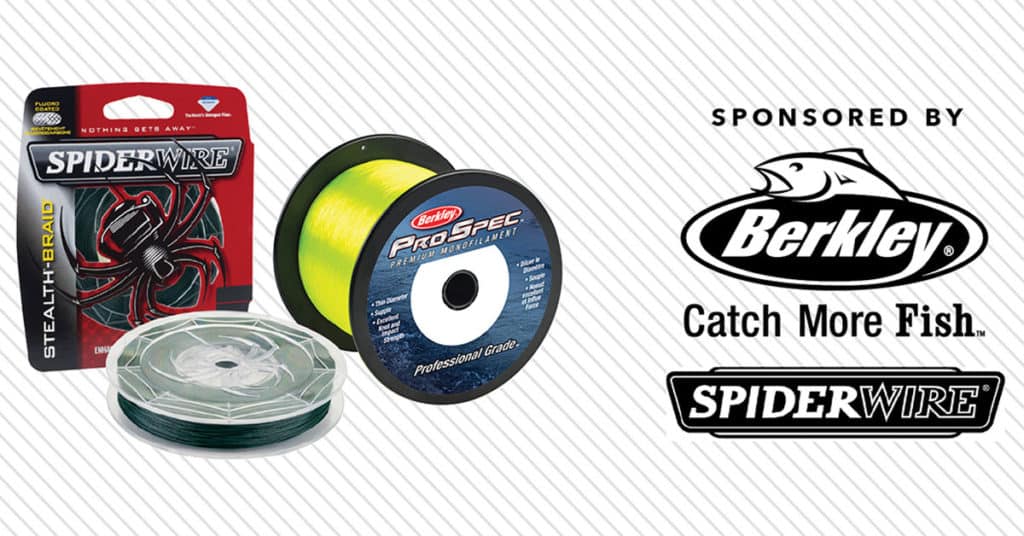
CHALLENGE OUR EXPERTS (And Win Up to 10,800 Yards of Line!)
Send in your question and any relevant photos of your mysterious catch or observation for our experts’ ID and feedback. If we publish your question and you have a shipping address within the United States or Canada, you’ll win a 3‑pound spool of Berkley Pro Spec ocean-blue or fluorescent-yellow monofilament (1,000 to 10,800 yards, depending on line strength) or a 1,500‑yard spool of Spiderwire Stealth braid up to 100‑pound‑test! Send questions and images via email to fishfacts@sportfishing.com (include your hometown) or via post to Sport Fishing Fish Facts, 460 N. Orlando Ave., Suite 200, Winter Park, FL 32789.

